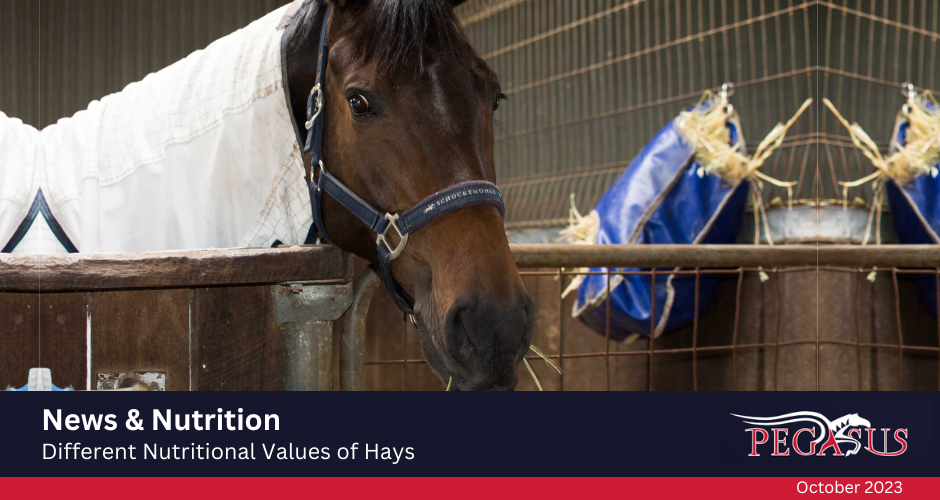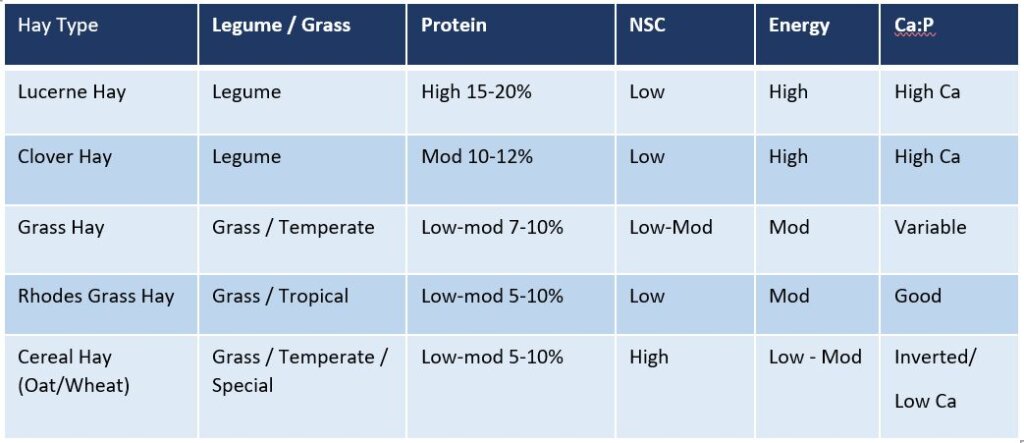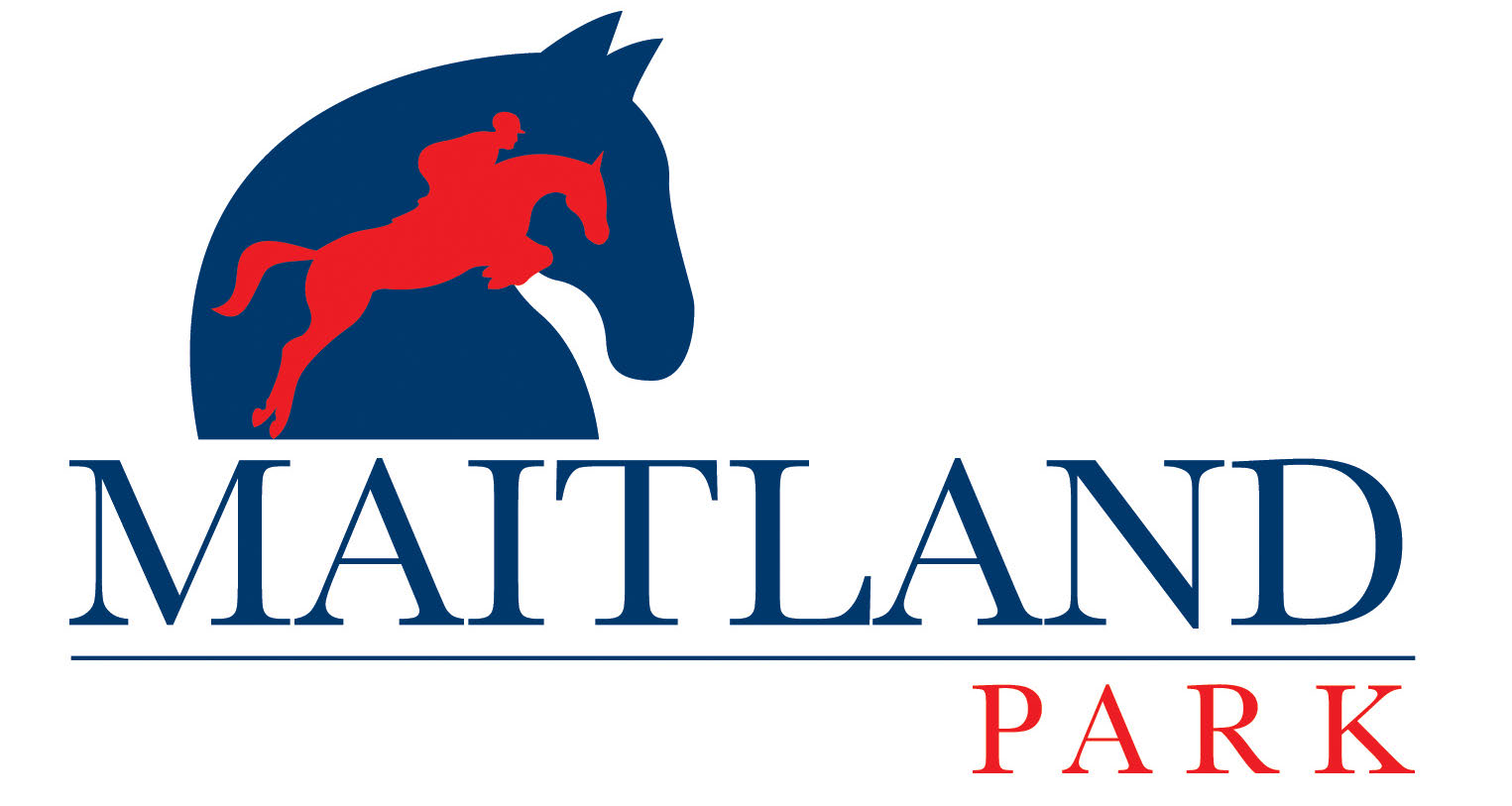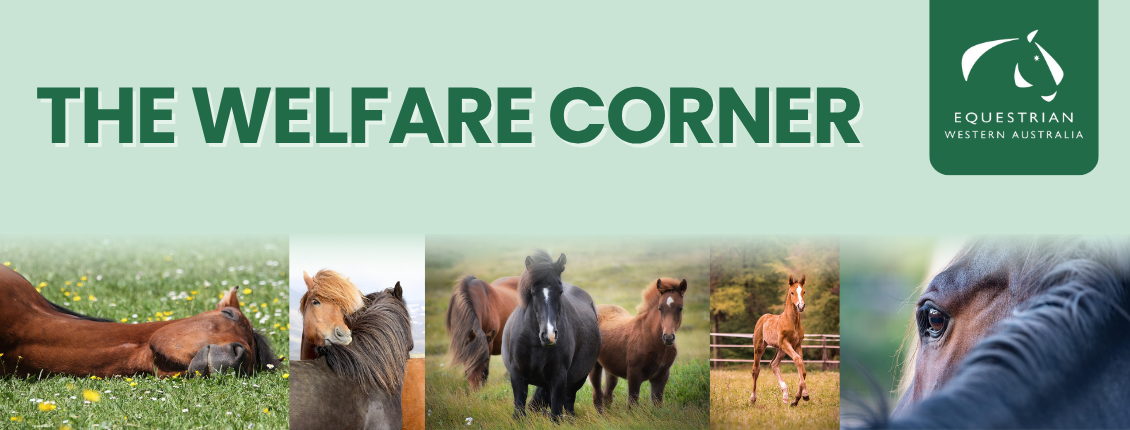
Pegasus News & Nutrition
Different Nutritional Values of Hay
Horses are often called ‘hay-burners’, and rightly so, given the amount of fibre they need to consume to maintain a healthy digestive system. Horses evolved as wandering herbivores with voluminous hindguts adapted to process large quantities of high fibre forage. Horses may eat anywhere from 1.5-3% of their body weight in roughage per day. The cecum and large colon (the hindgut) form a large fermentation vat, with billions of microbes that digest fibre to create energy, in the form of volatile fatty acids. The microflora of the hindgut consists of a delicate balance of bacteria, protozoa, fungi and yeasts, that are sensitive to changes in the diet, particularly changes in the quantity of roughage consumed. With this in mind, forage should be the foundation of every feeding program. The warm climate in Western Australia means that we rely on hay to provide that roughage for most, if not all, of the year. But we know that not all hays are the same. Here is a look at their key factors affecting nutritional value:
Forages are made up of two components: cell contents and cell walls. Cell contents contain most of the plant protein, starch and sugars (non-structural carbohydrates), lipids and organic acids. These components are degraded, mainly in the small intestine, by enzymes produced by the horse and are highly digestible. The cell walls contain the fibrous portion of the plant such as cellulose, hemicellulose and lignin. These components are resistant to digestive enzymes produced by the horse and are fermented in the hindgut. The two components contribute to determining the nutritional value of hay:
Fibre content (the proportion of the plant that is composed of cell wall)
Fibre quality (the degree of lignification, associated with stage maturity)
This is important because the horse can digest practically all of the cell contents, however bacterial fermentation can only digest 50% or less of most plant cell wall. Other factors that affect the nutrient value of hay include the species of plant, the stage of maturity, location where the plant was grown and the content of inhibitory substances.
Tropical plants tend to contain more protective structures, such as lignin and silica, whilst temperate plants contain more storage reserves, such as sugar and fructans. Inhibitory substances, such as lignin, add rigidity to plant cell wall, increase with maturity, and depress fibre digestibility; whilst silica strengthens the cell wall, is low in temperature plants, is high in straw (produces a glassy appearance), and also depresses fibre digestibility. Energy reserves such as sugar and fructans can provide a useful energy source for horses, however can be undesirable in diets for horses where a low non-structural carbohydrate level is required, such as horses suffering laminitis, obesity or metabolic diseases.
Whilst laboratory analysis of hay is the best way to determine nutritional value, fortunately for horse owners a visual assessment can be a good indicator of quality. Highly digestible fibre is high quality and has a leafy, softer appearance. A greener colour can often indicate a younger growth stage at time of cutting. Younger plants correlate with a higher nutritional value compared with mature plants. Later cut, mature plants have lower digestibility and lower nutritional value. They contain more lignin which gives them a ‘stemmy’, stiff appearance. Yellow, straw-coloured hay indicates mature growth stage. More stem, less leaf indicates lower digestibility and low energy. Regardless of plant species, age and growing location, hay should always be fresh-smelling and never be mouldy.
The most common types of hay available in WA are oaten/wheaten (cereal) hay, grass or meadow hay, lucerne hay and Rhodes grass hay. Of these varieties, oaten and wheaten have the higher sugar content, Rhodes hay has the lower sugar content, whilst grass hay and lucerne hay are in the middle. Sugar content is not the only factor to consider when choosing a hay for your horse. Some horses do very well on cereal hays, which tend to be palatable, clean and consistent in quality, whilst other horses may benefit from low sugar varieties of hay. Lucerne hay can be particularly beneficial for high-performance horses, and breeding or growing horse diets. Here’s a summary of the different types of hay:
Cereal – Oaten / Wheaten
- Temperate grass
- Easily grown in WA
- Stems and leaf greenish, seed head immature
- When harvested post-grain it is straw
- Quite palatable if harvested at right time
- Higher NSC content (~22-30%)
- Moderate protein and energy
Ryegrass Hay
- Temperate grass
- Often more golden in colour
- Thinner stalks/leaves
- Brownish tinge can mean baled too wet – caramelisation
- Variable quality/nutrient value
- Watch for mould / weeds
- Low to moderate NSC (~10-15%)
- Moderate protein and energy
Rhodes Grass Hay
- Tropical grass
- Light green in colour
- Best nutritional value pre-bloom
- Often cut for hay in late maturity = decline in digestibility
- Low fructan/NSC content
- Low-oxalate content
- Contains more lignin/silica – increases with maturity
- Variable quality and palatability
Clover Hay
- Legume hay
- Often yellowish on outside of bale
- Green with brown clover heads inside
- Can be susceptible to mould if baled when moist
- Higher protein, energy and calcium than grass hays
- Very palatable
Lucerne Hay
- Look at leaf-to-stem ration when selecting – indicates maturity at harvest
- Can be dusty
- High protein, energy and calcium
- Lower NSC than cereal hay (~11-16%)
- Highly palatable
Hay provides a vital, and often overlooked, part of the horse’s diet. Understanding different hays makes choosing the right hay for your horse easier. Regardless of the type of hay fed, ensuring it has a fresh smell, is free from dust, mould, weeds, and foreign matter such as dirt and stones is vital.
For advice on which type of hay best suits your horse, ask our equine nutrition advisor.

Note: these figures are a guide only, based on average analysis.
Article by Pegasus Feeds, 30.08.2022
For further Pegasus News and Nutrition articles, click here.












